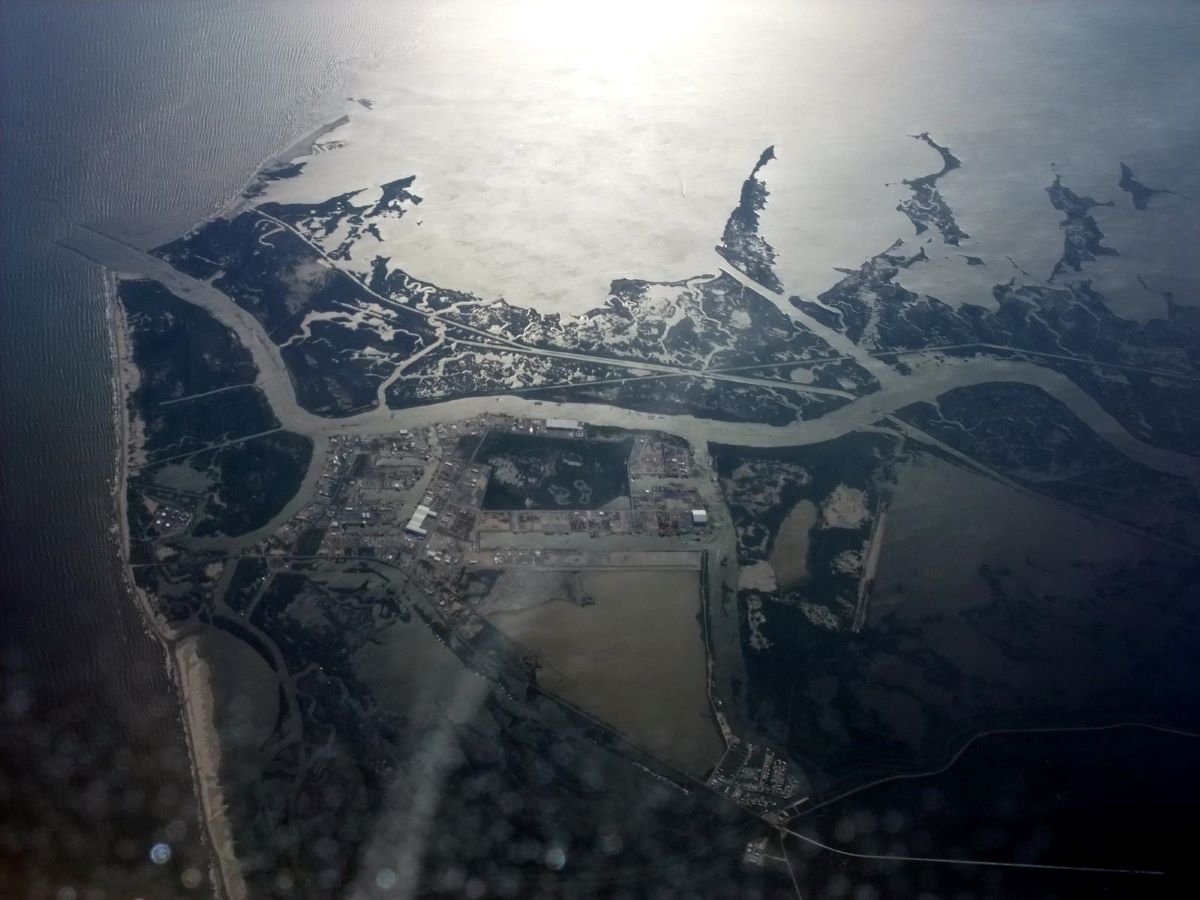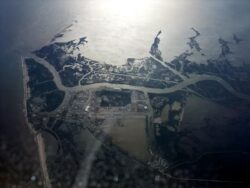Port Fourchon
Louisiana’s southernmost port on the Gulf of Mexico plays a critical role in the US energy industry.

Wikimedia Commons
Arial view of Port Fourchon. Photo by Kurt Bauschardt.
Port Fourchon, the nation’s busiest intermodal port along the Gulf Coast, is a lifeline to the US energy industry. The port acts as a land-based point where oil and gas transported from the Gulf of Mexico enter a pipeline network that supplies the country’s energy needs. It also serves as a deepwater service dock and harbor, providing industrial storage space. It performs numerous functions related to the service of the offshore oil and gas industry, such as providing a site for the transfer of fresh water, groceries, and bulk cargo like drilling fluid. According to a report issued by the Bureau of Ocean Energy Management, in 2019, the Gulf of Mexico produced 596.9 million barrels, or 15 percent, of domestic oil production.
Fourchon Pass, along with Belle Pass, were two historical water passes in the recent geological history of Lafourche Bayou, the main waterway that extends south through the heart of Lafourche Parish, an area of historical importance to the energy and seafood industries.
From the early nineteenth century onward, New Orleans was the nation’s premier southern port. It dominated the export and import market for many products, including, by the early twentieth century, tropical fruit like South American-grown bananas. According to multiple newspaper and magazine accounts, Albert Otto Rappelet, a colorful mid-twentieth-century French-speaking Louisiana politician, reportedly made a plea in the late 1950s to improve the docks at Fourchon Pass, which then consisted of isolated shrimp docks at Lafourche Bayou near the Gulf of Mexico. Rappelet argued for their improvement so that Lafourche Parish could compete in the lucrative tropical fruit trade. Reportedly a protégé of Dudley Leblanc, he would become state senator in 1939 and worked closely with Gov. Jimmie Davis to pass Act 222 of the state legislature in 1960, which established the Greater Lafourche Parish Commission, a governing body of the parish whose authority extends south from the Intracoastal Waterway to the coast, where Port Fourchon sits today.
According to Rappelet’s obituary, he was an originator of the idea behind an industrial park at the mouth of Bayou Lafourche. Port Fourchon, which developed on property originally owned by Caillouet Land Co. and Louisiana Land and Exploration Co., never developed into a fruit importing center but instead grew into a small port servicing local industry under the direction of the Greater Lafourche Parish Commission. Building a clamshell road and dredging Belle Pass in the late 1960s generated the first industry for the nascent industrial port. Creating a harbor police department and hiring visionary Executive Director Ted Falgout in 1978 led to the first major client, Martin Fuel, opening business in a rented dock space at the port the next year.
The opening of Louisiana Offshore Oil Port (LOOP) in the Gulf of Mexico in the early 1980s raised expectations for the port’s development. However, the oil industry’s downturn in the 1980s slowed the overall growth of oil-related employment and investment in the Gulf for many years. Port Fourchon benefitted during this time, as the downturn necessitated streamlining and efficiency among major oil companies and capital consolidation between various independents and service supply businesses operating out of regional waterways. Under Falgout’s direction, port officials envisioned a progressive future in which the dock maintained relevance by servicing oil and gas exploration and production in the “deepwater” of the Gulf of Mexico. By the late 1980s port directors developed plans for the revolutionary E-Slip, an extensive canal system dredged into the surrounding wetlands with far-reaching waterfront property and transport available to a range of industrial clients. Plans for building the slip proved timely, as major oil companies shifted energy exploration a few hundred miles offshore into depths of thousands of feet of water.
With the future promise of unique deepwater servicing capabilities, Port Fourchon emerged as a competitive harbor for offshore oil and gas vessels, workers, and associated transportation vehicles like eighteen-wheelers and helicopters. Dock revenue increased over the first half of the 1990s and exponentially ballooned with the passage of the Deepwater Royalty Relief Act of 1995, encouraging further exploration in deepwater. Exploration and oil and gas production in the furthest depths is expensive, with leading oil companies estimating upward of a few billion dollars per deepwater project. The act promised a few years during which companies would enjoy profits from oil and gas produced in the deep Gulf with substantially reduced royalties owed to the federal government.
Although the Deepwater Royalty Relief Act expired in the early 2000s, companies continued to exert considerable efforts in the Gulf that directly benefitted Port Fourchon, which recorded unprecedented growth. Earlier development led to the 1996 formation of the LA 1 Coalition, dedicated to the elevation of Louisiana Highway 1, the only land-based route accessible to Port Fourchon. The commission formed to obtain funding for a phased project that aimed to elevate various sections of the highway above the surrounding marsh. The wetlands, some of the most pristine in the United States at the beginning of the twentieth century, were degrading faster than anywhere else in the nation by century’s end, and the vital highway was prone to frequent flooding. The highway and its connection to the port led to the road’s designation as a necessary “energy corridor” and the elevation of the highway as a high-priority project.
With the further expansion of port facilities, improvement of dock capabilities, and acquisition of additional property, including the South Lafourche Leonard Miller Jr. Airport and its surrounding property in 2001 from the Lafourche Parish Government, Port Fourchon emerged as the nation’s premier deepwater port by the end of the first decade of the new millennium. Located north of the port in Galliano, the airport proved vital in providing additional transportation services in the form of helicopters to the critical energy corridor of south Lafourche Parish.
Although an offshore drilling moratorium due to the 2010 BP oil spill and improvement in land-based oil production technologies such as fracking has led to a downturn in all but the most profitable offshore oil ventures, Port Fourchon remains competitive by remaining progressive. Further improvements to the port’s capabilities have led to a possible future servicing renewable energies, as the port is one of the few capable of servicing offshore wind turbines. Constructed partially on land and shipped to areas of proven wind production, the large wind turbines can only be stored, built, and maintained in deepwater ports like Port Fourchon. In addition to renewable energy, the port has a record of dune restoration and wetland construction. Such coastal restoration efforts come in response to beach and marsh erosion that threaten the vital infrastructure of the nation’s energy supply. The restored wetlands also serve the port’s capabilities to withstand direct storm hits such as Hurricane Ida in the fall of 2021. The hurricane tore through Lafourche and Terrebonne Parishes, causing immense destruction in the surrounding vicinity. However, Port Fourchon was open for business within nine days due to well-developed evacuation and storm preparation plans and damage mitigation from coastal restoration. Future funding streams for restoration ventures are mostly uncertain except at locales such as Port Fourchon, which has many willing industry partners.
